 W
WBarlaam and Josaphat are legendary Christian martyrs and saints. Their life story is very likely to have been based on the life of the Gautama Buddha. It tells how an Indian king persecuted the Christian Church in his realm. When astrologers predicted that his own son would some day become a Christian, the king imprisoned the young prince Josaphat, who nevertheless met the hermit Saint Barlaam and converted to Christianity. After much tribulation the young prince's father accepted the Christian faith, turned over his throne to Josaphat, and retired to the desert to become a hermit. Josaphat himself later abdicated and went into seclusion with his old teacher Barlaam. The tale derives from a second to fourth century Sanskrit Mahayana Buddhist text, via a Manichaean version, then the Arabic Kitāb Bilawhar wa-Būd̠āsaf, current in Baghdad in the eighth century, from where it entered into Middle Eastern Christian circles before appearing in European versions. The two were entered in the Eastern Orthodox calendar with a feast-day on 26 August, and in the Roman Martyrology in the Western Church as "Barlaam and Josaphat" on the date of 27 November.
 W
WSaints Chrysanthus and Daria are saints of the Early Christian period. Their names appear in the Martyrologium Hieronymianum, an early martyrs list, and a church was built in their honour over their reputed burial place in Rome.
 W
WSaints Cosmas and Damian were two Arab physicians in the town Cyrhus, and were reputedly twin brothers, and early Christian martyrs. They practised their profession in the seaport of Aegeae, then in the Roman province of Syria.
 W
WSaints Cyprian and Justina are honored in the Catholic Church, Eastern Orthodox Church and Oriental Orthodoxy as Christians of Antioch, who in 304, during the persecution of Diocletian, suffered martyrdom at Nicomedia on September 26. According to Roman Catholic sources, no Bishop of Antioch bore the name of Cyprian.
 W
WCyricus, and his mother, Julitta are venerated as early Christian martyrs. According to tradition, they were put to death at Tarsus in AD 304.
 W
WCyril and Methodius (815–885) were two brothers and Byzantine Christian theologians and missionaries. For their work evangelizing the Slavs, they are known as the "Apostles to the Slavs".
 W
WSaints Cyrus and John are venerated as martyrs. They are especially venerated by the Coptic Church and surnamed Wonderworking Unmercenaries because they are supposed to have healed the sick free of charge.
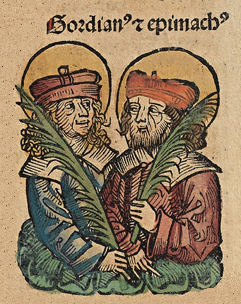 W
WSaints Gordianus and Epimachus were Roman martyrs, who are commemorated on 10 May.
 W
WFelix and Adauctus (d. 303) were according to tradition, Christian martyrs who were said to have suffered during the Great Persecution during the reign of the Roman emperor Diocletian.
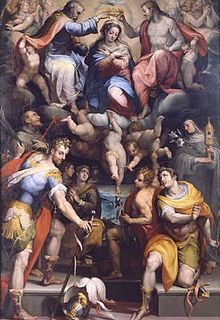 W
WNabor and Felix were Christian martyrs thought to have been killed during the Great Persecution under the Roman emperor Diocletian. A tomb in Milan is believed to contain their relics.
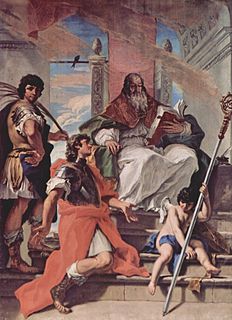 W
WSaints Firmus and Rusticus are venerated as two martyrs of Verona. Their unreliable Acts state that Firmus and Rusticus, kinsmen, were prominent citizens of Bergamo. They were martyred at Verona under the Emperor Maximian after refusing to sacrifice to pagan idols. Under the judge Anolinus, they were tortured, beaten with clubs, and beheaded.
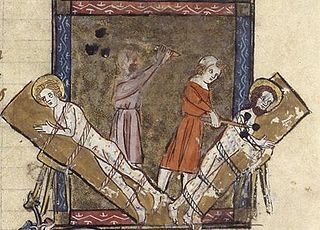 W
WSaints Gervasius and Protasius are venerated as Christian martyrs, probably of the 2nd century. They are the patron saints of Milan and of haymakers and are invoked for the discovery of thieves. Their feast day in the Latin Rite of the Catholic Church is 19 June, the day marking the translation of their relics. In the Eastern Orthodox Church and in the Eastern Rites of the Catholic Church, their feast takes place on 14 October (O.S.)/24 October (N.S.), the traditional day of their death. In Christian iconography their emblems are the scourge, the club and the sword.
 W
WJohn and Paul are saints who lived during the fourth century in the Roman Empire. They were martyred at Rome on 26 June. The year of their martyrdom is uncertain according to their Acts; it occurred under Julian the Apostate (361–3).
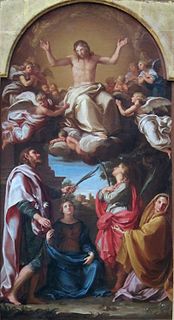 W
WJulian and Basilissa were husband and wife, and are venerated as saints in the Roman Catholic Church and the Eastern Orthodox Church. They were Christian martyrs who died at either Antioch or, more probably, at Antinoe, in the reign of Diocletian, early in the fourth century, on 6 January, according to the Roman Martyrology, or 8 January, according to the Greek Menaea.
 W
WSaints Justus and Pastor are venerated as Christian martyrs.
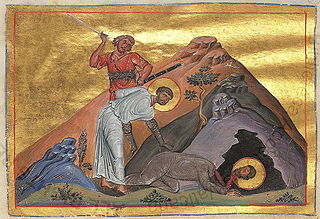 W
WSaints Juventinus and Maximus were members of the imperial guard of Emperor Julian. Their feast day is 25 January.
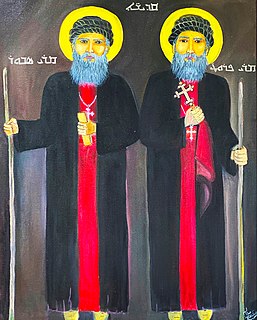 W
WMar Sapir and Mar Prot, according to Syrian Malabar Christian tradition, were two Syrian missionaries who landed in the port of Kollam in 823 AD. The mission is said to have received permission from the then king of Kerala to build a church in Kollam.
 W
WSaints Marcellinus and Peter are venerated within the Christian churches as martyrs who were beheaded. Hagiographies place them in 4th century Rome. They are generally represented as men in middle age, with tonsures and palms of martyrdom; sometimes they hold a crown each.
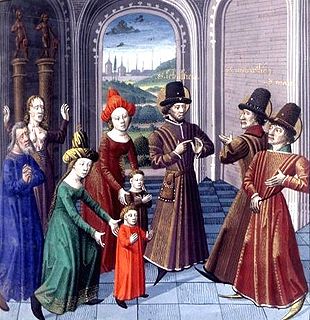 W
WMark and Marcellian are martyrs venerated as saints by the Roman Catholic Church and the Eastern Orthodox Church. Their cult is sometimes associated with that of Saints Tranquillinus, Martia, Nicostratus, Zoe, Castulus and Tiburtius, though not in the official liturgical books of the Church, which mention only Mark and Marcellianus among the saints for 18 June. Their mention in the General Roman Calendar on that date from before the time of the Tridentine Calendar was removed in the 1969 revision, because nothing is known about them except their names, the fact of their martyrdom, and that they were buried on 18 June in the cemetery of Santa Balbina on the Via Ardeatina.
 W
WSaints Nazarius and Celsus were two martyrs of whom nothing is known except the discovery of their bodies by Saint Ambrose.
 W
WSaints Nereus and Achilleus are two Roman martyr saints. In the present General Roman Calendar, revised in 1969, Saints Nereus and Achilleus (together) are celebrated on 12 May.
 W
WSaints Nunilo and Alodia were a pair of child martyrs from Huesca. Born of a mixed marriage, they eschewed the Islam of their father in favour of their mother's Christianity. They were executed by the Muslim authorities of Huesca in accordance with sharia law as apostates. Their feast day is 22 October.
 W
WPerpetua and Felicity were Christian martyrs of the 3rd century. Vibia Perpetua was a recently married well educated noblewoman, said to be a have been 22 years old at the time of her death, and mother of an infant she was nursing. Felicity, a slave imprisoned with her and pregnant at the time, was martyred with her. They were put to death along with others at Carthage in the Roman province of Africa.
 W
WThe Feast of Saints Peter and Paul or Solemnity of Saints Peter and Paul is a liturgical feast in honour of the martyrdom in Rome of the apostles Saint Peter and Saint Paul, which is observed on 29 June. The celebration is of ancient Christian origin, the date selected being the anniversary of either their death or the translation of their relics.
 W
WSaints Primus and Felician (Felicianus) were brothers who suffered martyrdom about the year 297 during the Diocletian persecution. The "Martyrologium Hieronymianum" gives under June 9 the names of Primus and Felician who were buried at the fourteenth milestone of the Via Nomentana.
 W
WSaint Willibald was an 8th-century bishop of Eichstätt in Bavaria.
 W
WSaints Sergius and Bacchus were fourth-century Roman Christian soldiers revered as martyrs and military saints by the Catholic, Eastern Orthodox and Oriental Orthodox Churches. Their feast day is 7 October.
 W
WSaint Susanna of Rome, according to Christian religion, a Christian martyr whose feast day is 11 August which is the same as Saint Tiburtius. The saints were not related, but they are sometimes associated because they are venerated on the same day.
 W
WSymphorian, Timotheus (Timothy), and Hippolytus of Rome are three Christian martyrs who though they were unrelated and were killed in different places and at different times, shared a common feast day in the General Roman Calendar from at least the 1568 Tridentine Calendar to the Mysterii Paschalis. While still a young man, Symphorian was either beheaded or beaten to death with clubs.
 W
WSaints Victor and Corona are two Christian martyrs. Victor was a Roman soldier who was tortured and killed; Corona was killed for comforting him. Corona is venerated in connection with treasure-hunting and, since 2020, with the 2020 coronavirus pandemic.
 W
WSaints Vitalis and Agricola are venerated as martyrs, who are considered to have died at Bologna about 304, during the persecution ordered by Roman Emperor Diocletian.
 W
WSaints Zenaida and Philonella were traditionally the first Christian physicians after Luke the Evangelist, and the first "unmercenaries". They are particularly venerated in Eastern Christianity